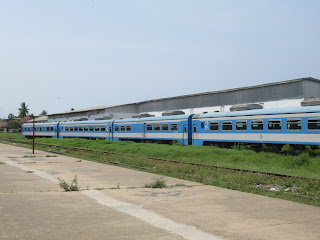Pointe Noire is the Congo's second largest city after its capital, Brazzaville with a population of over one million. It was named by Portuguese explorers in 1482 when they saw a black rock on the point and it became a maritime reference point for other ships. The French signed a treaty with the local chief in 1883 and established a fishing village here.
French Equatorial Africa was created in 1910. The Congo river is not navigable between the coast and the capital Brazzaville due to rapids so a railway was started in 1921 to contact the two cities. Pointe Noire is now a major port and a centre for the Congolese oil industry.
I was staying at La Brasserie del Mer which is on the beach.
The main entrance.
The decking on the beach front.
A view along the beach. The city is well known for its Cote Savage beaches.
It was a nice place but we were still camping around the side of La Brasserie...but I got an upgrade to a hotel.
In the centre of the city there is not much to see according to the guide book but I had lots to see. The main railway station. An odd mixture of arte deco and German alpine architecture.A view of one end of the building which needs some renovation, note the hole in the roof.
And a closer view of the tower and an even bigger hole in the roof. I hope that it is repaired and preserved rather than pulled down and rebuilt as the building is of architectural merit.
...one of the carriages...
...the carriages of La Gazelle which is the three times a week train to Brazzaville. The more than 500kms journey takes 14 hours but I didn't have sufficient time to take the train in both directions.
One of the original locomotives dating from 1921 preserved nearby.
The catholic church which is part of the Catholic School, a large concrete built building from the early 20th century.
And there were plenty of arte deco buildings, all dating from about the same time in the early 20th century and a popular architectural style in the 1920's and 1930's. The town hall.
Another government building.
Yet another arte deco building.
...and the Italian oil company ENI's local office building.
And I had an upgrade to a hotel but I had already booked in on line before I found the Atlantic Palace Hotel which was just up my street in opulence and quality but rather expensive.
The bar area.
The swimming pool.
The gardens.
And then it was back to La Brasserie for the last night in Pinte Noire before an early start to cross the border and go right across Cabinda to reach Condo DRC (formerly Zaire but since renamed).
























Hello - Excellent report and many thanks for the great color photos from Congo. I'm currently writing a report about the history of the railways in that giant country and would like to include your photos of the train station and the rolling stock, with your permission. Please get back to me at alonsitt (at) gmail.com
ReplyDeleteThanks!
Alon